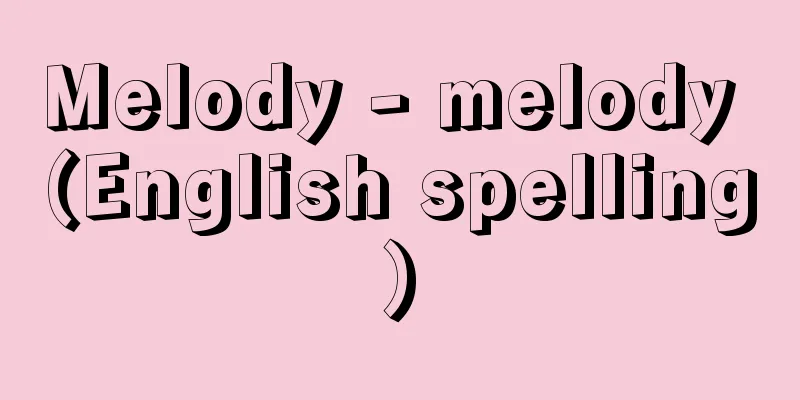Melody - melody (English spelling)

|
In musical terms, it is also called "melody" or "fushi". In the early Meiji period, inspired by the traditional Chinese musical term "xiangong", it was named "something that goes around the rhythm" in reference to the movement of high and low tones. Generally, melody is contrasted with rhythm and harmony (continuous succession of chords, harmony) as the "three elements of music", but if the rhythmic element is removed from melody, it becomes a meaningless string of musical tones, which does not deserve to be called a melody. This is called a pitch line, and melody can be considered a complex consisting of this pitch line and rhythm. However, even if it has these two elements, if it is fragmentary or an inner voice of harmonic music, it is often not called a melody. To be a melody, the series of musical tones themselves must be a unit that has some musical expressive intention. In other words, melody can be defined as a successive connection or movement of a series of musical tones that are musically cohesive. Such melodies can express a variety of content by combining different pitches and rhythms. Generally, ascending melodies express tension, descending melodies express relaxation, melodies with accented rhythms express excitement, and melodies with even rhythms express calm. On the other hand, melodic movement is not completely free, since it is formed within a certain sound structure. Modal and key structures impose various constraints on the formation of a melody. In addition, the performance and range of the performance medium (voice or instrument) are also one of the most fundamental conditions for the formation of a melody. Based on style, melodies are classified into three types: (1) monophony (single-voiced melodic style), (2) polyphony (polyphonic style), and (3) homophony (a style that includes harmony). [Toshiaki Kurosaka] [Reference] | | |Source: Shogakukan Encyclopedia Nipponica About Encyclopedia Nipponica Information | Legend |
|
音楽用語で、「メロディ」または「節(ふし)」ともいう。明治初期に、中国の伝統的音楽用語であった旋宮(せんきゅう)からヒントを得て、音の高低の動きに対して「律を旋(めぐ)るもの」として名づけられた。一般に「音楽の三要素」として、旋律は律動(リズム)と和声(和音の継続的連続、ハーモニー)に対立させられるが、旋律からリズム的要素を取り除けば楽音の無意味な羅列となり、これは旋律とよぶに値しない。これは音高線とよばれ、旋律はこの音高線とリズムからなる複合体と考えることができる。ところが、この二つを備えていても、それが断片的であったり、和声的音楽の内声であったりすれば、それも旋律といわないことが多い。旋律であるためには、楽音の連なりそのものが、なんらかの音楽的表現意図をもった一つのまとまりでなければならない。つまり、旋律は音楽的にまとまりをもった一連の楽音の継時的つながり、または運動と規定することができる。 このような旋律は、音高線とリズムをさまざまに複合することによって、多彩な内容を表現しうる。一般に、上昇旋律は緊張、下降旋律は弛緩(しかん)、アクセントのあるリズムの旋律は興奮、均等なリズムの旋律は平静を表すとされる。 他方、旋律の動きは一定の音組織のなかで形成されるため、まったく自由に行われるわけではない。旋法組織や調組織などが、旋律の形成にさまざまな制約を与える。また、演奏媒体(声や楽器)の性能や音域も、旋律形成のもっとも根本的な条件の一つとなっている。 なお、旋律は様式上から、〔1〕モノフォニー(単旋律型)、〔2〕ポリフォニー(複旋律型)、〔3〕ホモフォニー(和声を伴う旋律型)の三つに類別される。 [黒坂俊昭] [参照項目] | | |出典 小学館 日本大百科全書(ニッポニカ)日本大百科全書(ニッポニカ)について 情報 | 凡例 |
<<: Zenritsukata - Zenritsukata
Recommend
Shuho Takashima - Shuho Takashima
Year of death: 14th January 1866 (28th February 18...
Market manipulation - Soubasoujuu
The act of artificially fluctuating or fixing pric...
Kishizawa Shikisa (5th generation)
[Born] Bunka 3 (1806) [Died] December 19, 1866 (Ke...
Curve Salvation - Kyokusenkyukoku
... In October of that year, Wuhan was occupied b...
Suppuration - Possible
This refers to suppurative inflammation, a type o...
Emphyteusis - emphyteusis
It refers to the right to use someone else's ...
Gladiolus - Sword Lily
A bulbous plant of the Iridaceae family (APG clas...
Entrance examination
An exam to select those who will be admitted from ...
Organs of movement
… In addition to the concept of organs from the p...
Chlorapatite (chlorine apatite)
A type of phosphorus-containing mineral. It is wid...
Kiritsukoushokaisha - Kiritsukoushokaisha
…Aizu, Shizuoka, and Kuroe lacquerware were also ...
Return to blue
A blue cobalt pigment used in blue and white dyein...
Mihirakula
…The initial invasions were repelled by Skandagup...
Village-kun
It refers to a leader in fishing in a fishing vil...
Changsung (English spelling)
A wooden (or stone) deity statue that stands at th...









